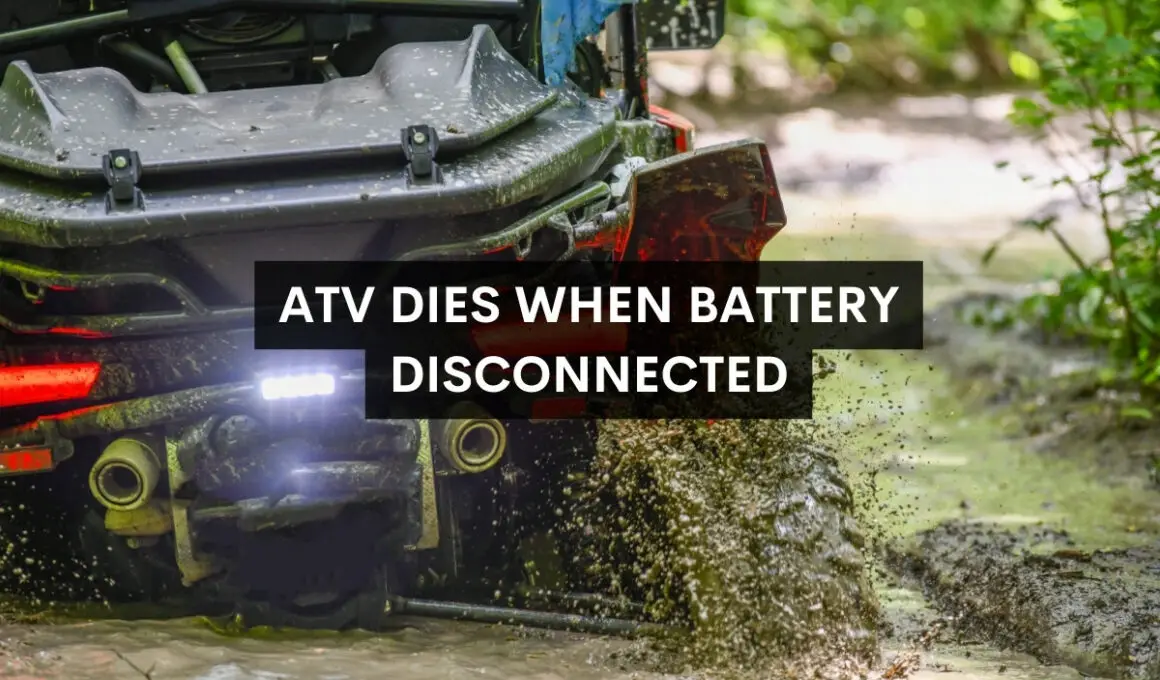In This Article Show
Having spent years navigating the rugged terrains and tinkering with every off-roading equipment imaginable – from nimble dirt bikes to robust ATVs and UTVs – I’ve encountered just about every hiccup these machines can throw at you.
One of the most perplexing issues riders encounter is when their ATV suddenly dies upon disconnecting the battery. It might seem like a minor glitch, but it speaks volumes about the health of your vehicle’s electrical system.
You don’t need an engineering degree to understand or even fix this. That’s where my experience comes into play. With this guide, I’ll walk you through the fundamental reasons behind this phenomenon and offer straightforward solutions. Let’s get started.
The Basics of ATV Electrical System
Off-roading might be about embracing the wild, unpredictable terrains, but precision and predictability are crucial when it comes to the heart and soul of our ATVs – the electrical system.
Just like our body has the circulatory and nervous systems working in tandem, the ATV has its intricate web of electrical components, each playing a pivotal role. Let’s break it down, piece by piece. Below are the components of the electrical system:

1. Battery
Think of the battery as the lifeblood. It stores and supplies electrical energy. Every time you start up your ATV or run any electrical accessory, you’re drawing power from this reservoir.
2. Stator
Hidden within the engine, the stator is essentially your ATV’s generator. When the engine runs, the stator produces electricity, part of which keeps the battery charged and the rest powers the vehicle’s electrical systems.
3. Regulator/Rectifier
This is the brain behind electricity management. The electricity produced by the stator isn’t always steady or in the right form. The regulator/rectifier ensures that the electricity flowing to the battery and other components is both consistent and in the correct voltage.
4. Ignition System
This is the spark that brings your ATV to life. The ignition system uses power from the battery to generate the spark needed to ignite fuel in the engine, setting the whole system in motion.
By understanding these key components, you’re not just leveling up your ATV knowledge but also ensuring you can identify when something’s amiss. After all, an informed rider is always a step ahead.
Why Does an ATV Die When the Battery is Disconnected?
Disconnecting a battery while an ATV is running and seeing it die can be quite a puzzling experience for many. After all, isn’t the engine itself supposed to generate power? Well, it does, but there’s a catch. Let’s break down the ATV’s electrical system’s interplay when the battery is removed from the equation.

The Role of the Battery in Maintaining Electrical Charge
Stabilizing Force
The battery doesn’t just store power; it acts as a stabilizing force. When power demands change (say, revving the engine or turning on lights), the battery smoothens out these power fluctuations, ensuring all electrical components receive a consistent supply.
Voltage Buffer
Sudden spikes or voltage drops can harm electronic components. The battery acts as a buffer, absorbing excessive voltage and supplementing when there’s a shortfall. This prevents potential damage and keeps everything running smoothly.
Battery and the Ignition Process
Even after the initial start-up, the ignition system relies on the battery. Without it, there might not be enough consistent power to keep the spark going, leading to an engine that sputters and dies.
In simpler terms, think of the battery as the anchor of a ship. While the ship (or in our case, the ATV) has the power to move and navigate, without its anchor, it can drift or become unstable in turbulent waters.
The battery ensures your ATV stays “anchored” with a steady supply of power, and without it, the system can falter. So, the next time someone wonders why their ATV can’t run without a battery, you’ll have the insights to share, and the wisdom to prevent potential hiccups in your own machine.
Common Causes for ATV Dying upon Battery Disconnection
Understanding why an ATV might die upon battery disconnection is one thing, but pinpointing the exact cause can be another challenge altogether. There are a few typical suspects to consider when troubleshooting. Here’s a breakdown of these common culprits:
1. Faulty Alternator/Stator
If your ATV’s stator isn’t functioning properly, it may not generate enough electricity to keep your machine running without the support of the battery. A weak or malfunctioning stator can cause the ATV to rely heavily on battery power. Once disconnected, the ATV can’t sustain its electrical needs.
2. Bad Regulator/Rectifier:
The regulator/rectifier’s primary role is to ensure a steady flow of electricity and convert the stator’s AC power into DC power for the battery. If it’s faulty, it might not manage these tasks efficiently, leading to unstable power distribution. With the battery out of the picture, this issue becomes even more pronounced, causing the ATV to die.
3. Ignition System Issues
The ignition system’s continuous need for power can make it vulnerable when the battery is disconnected. If there’s any flaw or weakness within this system, it could struggle to draw the required power solely from the stator, resulting in the ATV shutting down.
4. Wiring Problems
Electrical issues aren’t always about the big components. Sometimes, it’s the intricate web of wires that’s the issue. Frayed wires, corroded connections, or even loose connectors can interrupt power flow. When the battery, a primary power source, is disconnected, these issues can become significant enough to stall the ATV.
Armed with this knowledge, you can approach the troubleshooting process with a clearer perspective. Identifying the root cause is always the first step in resolving any problem. And with our ATVs, ensuring they run smoothly without hitches is paramount for both our enjoyment and safety.
Fixes and Solutions
Encountering an issue with your ATV can be a bit daunting, especially when it’s related to the electrical system. But fear not; armed with the right knowledge and tools, resolving these issues can be quite straightforward. Let’s explore some fixes and solutions for the common causes we discussed:

Testing the Alternator/Stator
Tools Needed: Multimeter.
Procedure
- Set your multimeter to AC voltage.
- Connect it to the wires coming from the stator.
- Start the ATV and gradually rev the engine.
2. Checking the Regulator/Rectifier
Tools Needed: Multimeter.
Procedure
- First, check for any signs of physical damage like burning or melting.
- Next, with the multimeter set to DC mode, measure the voltage across the battery terminals without the engine running.
- Now, start the ATV and check the voltage again. It should be higher (usually between 13.5 to 14.5 volts for a 12V system) indicating the battery is receiving a charge.
- If there’s no change or the voltage is too high/low, the regulator/rectifier may be the issue.
3. Inspecting the Ignition System
Tools Needed: Spark plug tester.
Procedure
- Disconnect the spark plug cap and insert the tester.
- Start the ATV. A functioning ignition system should produce a bright blue spark.
- A weak or inconsistent spark, or no spark at all, indicates a problem. It could be the coil, CDI box, or even the spark plug itself.
4. Thorough Wiring Check
Tools Needed: Visual inspection, multimeter.
Procedure
- Begin by visually inspecting all visible wires and connections for signs of damage, corrosion, or disconnection.
- Use the multimeter to check for continuity in suspect wires. Ensure all ground connections are secure.
- Remember, sometimes a simple loose connection can be the root of the problem.
5. Battery Maintenance
Ensure your battery is in top condition by checking its voltage regularly. A healthy 12V battery should read around 12.6V to 12.8V when fully charged. Also, keep the terminals clean and free from corrosion, ensuring the connections are tight.
By systematically addressing each potential issue, you can restore your ATV’s performance and reliability. Regular checks and maintenance go a long way in preventing these problems, ensuring you can enjoy your off-roading adventures without unexpected interruptions.
Wrapping It Up
Navigating the intricacies of an ATV’s electrical system might initially seem like venturing into a dense forest. But as we’ve journeyed together through this guide, I hope the path has become clearer and more manageable.
Understanding why an ATV dies when its battery is disconnected, recognizing the common culprits, and being equipped with actionable solutions can make all the difference in your off-roading experiences.
It’s not just about addressing the issue at hand, but about ensuring the longevity and optimal performance of your beloved machine.
The world of off-roading offers unparalleled thrills, scenic views, and challenges that stir the adventurer in all of us. By ensuring that our ATVs are in top-notch condition, we not only safeguard our rides but also enhance the enjoyment and memories we create along the way.










